This will be about how the group recreated the song 'Come As You Are' by Nirvana
Don't wanna be here? Send us removal request.
Text
Reflective Report
For this reflective report, one will understand the process that went with the assignment project on recreating a producer’s ‘sonic signature, with the recording techniques, types of microphones used, and post-editing techniques used. Also, one will acknowledge, the positives and negatives that happened through this project and what should be improved when recreating a song, for the foreseeable future.
The aim for this project was to recreate Butch Vig’s famous song, ‘Come As You Are’ by Nirvana, this song was chose, because it had a huge impact to the music industry for the future, as, “Musically, it popularised a sound and a DIY aesthetic without which there’d arguably be no Arcade Fire or Radiohead, White Stripes or Wolf Alice.” (Hall, 2016).
As for the choices on microphones, they were different on each instrument, for the drum the microphones were two Neumann KM 184, for the overheads, two Shure SM57 for the top and bottom of the snare and an AKG D112 for the kick drum. The recording sounded good for the drums, as the microphones used were suitable to recreate the track with using the SM57 for obtaining that snapping sound, that the original track possessed, as “… SM57's low-end 200Hz roll-off is doubtless part of its appeal, combating proximity-effect bass boost when it's used up close, as well as minimising kick-drum spill. The other response characteristics (a 300-500Hz dip and a generous 2-12kHz presence peak) serve to reduce muddiness and add more 'snap'” (Senior, 2008). The only problem was by not adding a Moongel to the snare, because that would have made the snapping sound clearer and could’ve also have saved time on the EQ for the snare during post-editing, which had to be carefully changed to get close sound. Also, the AKG D112 was chosen because of the punch effect it had on the recording, which the original kick on the track consisted through the song, as “…while the D112 also has a pronounced presence boost at 3kHz that really emphasises beater definition…” (Senior, 2008). The only problem the group encountered was the fact of the mic position during recording, was wrong, as it didn’t capture the punching sound perfectly, so some post-editing was to be done, specifically with the EQ, to make sure the punching sound was boosted enough to stand out. Going for the Neumann KM 184, as the overhead microphones, were good for picking up the drum kit as a whole especially using the XY overhead technique with a low height, as it captured the sound directly from the kit and not from the room, the only part on post editing done was to include an EQ to move the frequency of the sound similarly to the original version of the song. Also, for the drum kit post-editing a soft room reverb was added to recreate the original track. The only major problem with the drum kit was, the fact it didn’t sound completely tight and the problem could’ve been from looping some parts of the drum kit constantly, while other parts had less of the treatment and using beat detective too incorrectly.
For the bass guitar, it was decided by the group to use a Shure SM57 for the ambience microphone, Sennheiser MD 421 for the amplifiers microphone and a DI Box, which this option was suitable for getting as close to recreate the track. The reason on why the group decided to go for the MD 421 was because of the good quality it possessed when recording with loud amplifiers and the fact that Butch Vig using this microphone during recording, as “It can handle extremely high SPLs without distorting, which makes it a popular pick for the loudest amplifiers. A five-position bass roll-off switch gives you impressive power to sculpt the frequency response and helps you manage proximity effect when close-miking your amplifier.” (Sweetwater, 2015). The only thing that was post-edited was to slightly change the EQ to make sure that it sounded similarly to the original track. Initially both the SM57 and the DI Box were part of being in the final track of the recreated song, but after listening carefully and trying to do some post editing, both were dropped altogether, which was decided as a whole group. The ambience microphone wasn’t needed only because there wasn’t much room reverb on the original version of the song.
The guitar had two different parts, which it was a clean and a distorted part of the song. The set-up for these two different parts were the same, but the only difference was the amplifier set-up for these parts. The microphones were the Shure SM57 to the left and the Sennheiser MD 421 on the right of the front amp, an Electro-Voice RE20 behind the amp, an AKG C451 B for the ambience and a DI Box. Similar to the bass guitar, both the ambience and the DI Box were removed during post-editing, also the SM57 was removed from the track. The reason on why the inclusion of a back mic was because the sound recording will be more diffused than the front of the amplifiers microphones. The editing on the guitar was to make sure that the EQ was at a decent low-middle end, so it sounded like the original track and it was successful in the end, also the group made sure that everything sounded well by looping some parts and everything was tight as a track with the bass guitar.
For the vocals, two microphones were used, both a condenser and a dynamic microphone. While recording, the singer wasn’t doing a great job with recreating the vocalist on the original track, as the singer sounded aggressive and rough, this could’ve been avoided only if there was a different singer who can closely recreate the original vocalist’s voice and key notes throughout the song. For the post-editing, a compressor was added to make sure that the voice sounded more smoother and included a light room reverb too, like the drum kit’s reverb, so that it sounded similar to each other.
References
· Hall, J (2016) Nevermind at 25: how Nirvana's 1991 album changed the cultural landscape [online]. Available from: https://www.telegraph.co.uk/music/what-to-listen-to/nevermind-at-25-how-nirvanas-1991-album-changed-the-cultural-lan/, [Accessed on the 15th May 2018]
· Senior, M (2008) Kick & Snare Recording Techniques [online]. Available from: https://www.soundonsound.com/techniques/kick-snare-recording-techniques, [Accessed on the 15th May 2018]
· Sweetwater (2015) How to Get a Great Guitar Sound with Sennheiser Microphones [online]. Available from: https://www.sweetwater.com/insync/how-to-get-a-great-guitar-sound-with-sennheiser-microphones/, [Accessed on the 16th May 2018]
0 notes
Text
6/5/2018 - Second Post Edit
Today was the final edit for this project, as major changes were made to have a better-quality track. Firstly, the drums had a popping sound which was made from using the beat detective incorrectly, so by re-using the untouched original drum track and using beat detective properly, the popping sound vanished. The kick and snare had to have a careful treatment on the EQ to make it sound like the original kick and snare on ‘Come As You Are’ and also it was decided to remove the bottom snare, ambience microphones and the DI Box in the track, as it didn’t fit with the original track. Also, EQ was added to the bass guitar and some panning was made with the main riff on the right and the snare on the left, because when listening the original track, these instruments were panned slightly to these directions.
0 notes
Text
2/5/2018 - First Post-Edit Session
The group had used an edit suite from 10:40 until 13:00, as the focus for today was to make sure the first half of the song sounds well. Firstly, a compressor added on the vocals to make sure it sounds smooth and added an aux channel for main riff guitar group, which included plugins such as the D-verb, EQ 1 band and Compressor. Also, another aux channel for the drums was added with the D-Verb. Afterwards, a fading out was implemented on the bridge guitar and managed to loop the solo guitar and hi-hats.

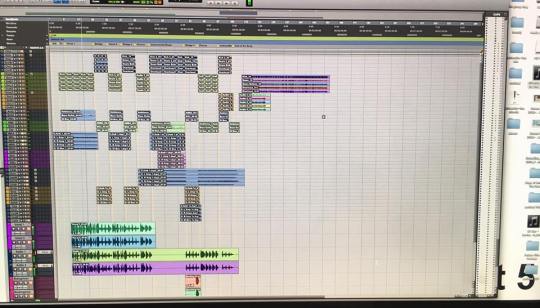
0 notes
Text
1/5/2018 - Fifth Recording
The objective for this session was to record the vocalist’s part of the song, but before that, there had to be some minor editing with the guitar, which it didn’t sound as grungy like the original guitar that Butch Vig recorded, so the solution to this was to tone down the guitar slightly. As the singer was invited to record, the group had a listen to Kurt Cobain’s vocals and noticed that the best way to get as close to that vocal was to include two microphones, both a condenser, to get the air effect on the track and a dynamic microphone, to get a lot of the dynamic vocal range. As the recording went on, the vocalist was singing a bit louder and aggressive, unlike how Kurt sang, so some members of the group asked the vocalist to sing less aggressive through the track. After that, the vocalist had to record the backing vocals.
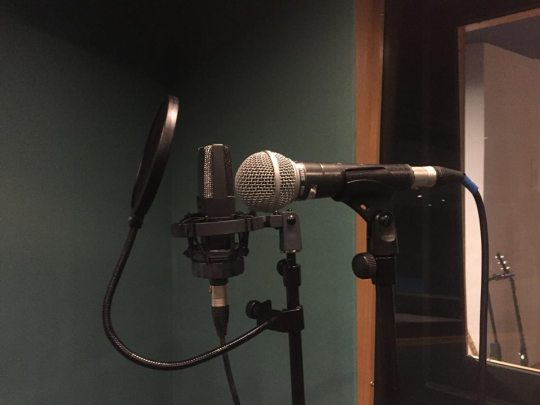
0 notes
Text
30/4/2018 - Fourth Recording
The studio will be booked for the fourth time, also, this time the studio was booked from 09:30 to 16:30, which was seven hours in total. The aim is to manage to record two different guitars which sound clean and distorted, for recreating the guitar part of the song, the group also agreed on to move recording the vocal for a different date, only because the guitar had to be taken care a lot more, as this required more time. But before starting recording the guitars, the ending of the bass guitar needed to be fixed and after thirty minutes, the problem was sorted. For the set-up, it was going to be like the bass guitar, but the only difference was adding an extra microphone to the front and a microphone behind the amp. The microphones used were a Shure SM57 to the left and the Sennheiser MD 421 on the right of the front amp, an Electro-Voice RE20 behind the amp, an AKG C451 B for the ambience and a DI Box.

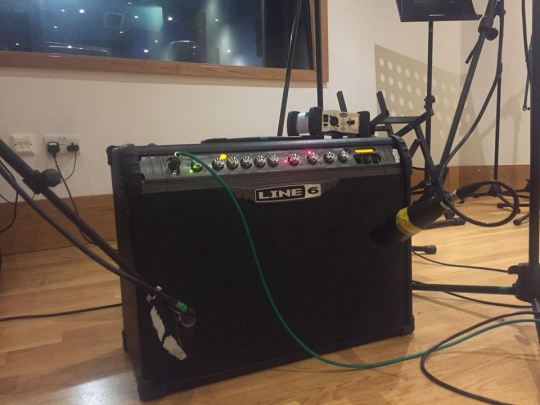
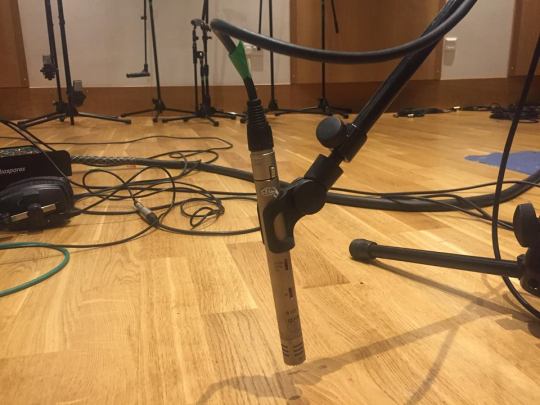
Including a microphone behind the amp was because of having a different timbre compared to the microphones in front of the amp, also by having two different microphones in front of the amp, the sound recorded will have a different quality from each other, so therefore the group can decide which one is more like the original version of the guitar. Firstly, the clean guitar was going to be recorded and it was decided by everyone in the group, that the guitarist should play only the first main riff and then loop that section through the whole song except the ending. Also, while listening the guitar part, some of the microphones didn’t sound as well as the original recorded guitar part, but it was best to keep these recordings, just in case when post-editing these tracks, can make them sound more like the original. After that, the distorted guitar was recorded playing only the first bridge and a chorus part was recorded too.
0 notes
Text
24/4/2018 - Third Recording
For the third recording, the group had to re-record the ending part of the drum again, so that the drums will sound cleaner and tighter, like Butch’s drum recording, with the editing made on the other parts during the last session. The recording set-up is going to be the same as last time, by having two microphones on the snare (both Shure SM57’s), 2 overhead microphones (both Neumann KM 184’s) and one kick drum microphone (AKG D112).
It was originally planned to record the ending of the song, but because the drummer needed more time to record that ending perfectly, it was then decided by the group to start recording from the instrumental break before the ending. This session only lasted for an hour, because the drummer wasn’t available to record any time later and the studio was available for that hour, but the recording was successful. Also, it was decided by the group to move on, to recording the drums for the next session, which it’s in the 30th April 2018.
0 notes
Text
21/4/2018 - Second Recording
After the first recording, the bass had to be re-recorded the same way as the last time, using the Mark Bass amp, to recreate the same sound as to the original version, when Butch Vig recorded Nirvana, this was re-recorded only because the reverb on the amp had to be altered to match with the original. The equipment used for recording was the same as last time, the microphones used were the Shure SM57 for the ambience, the Sennheiser MD 421 for the amp and a DI Box.
Also, the group decided to have a thorough listen to the drums and noticed that the drum recording wasn’t tight, but too dense, unlike how Butch Vig recorded the drums, so to fix this problem, it was decided to use the beat detective to fix this problem. The snare part had to be also edited, by choosing the best snare section and looping it through the song. Also, the group managed to notice these errors by having the actual song on the Pro Tools session.
0 notes
Text
28/3/2018 - First Recording
The Group has decided to book the studio for the 28th March 2018, which commences from 12:00, up until 16:00. The group decided that recording the drums first was the best option, so the guitar would be able to follow on the drums as a reference and manage to recreate the track.
The set-up for the drums was two overhead microphones (both Neumann KM 184’s), two microphones on the snare (both Shure SM57’s) and one microphone placed on the kick drum (AKG D112). The group decided to go with these microphones, as they were the best quality microphones available to use in that studio. Also, it was agreed on to go for this recording layout, because on the original track, the drum section has a defined snare and kick hit, throughout the whole song.
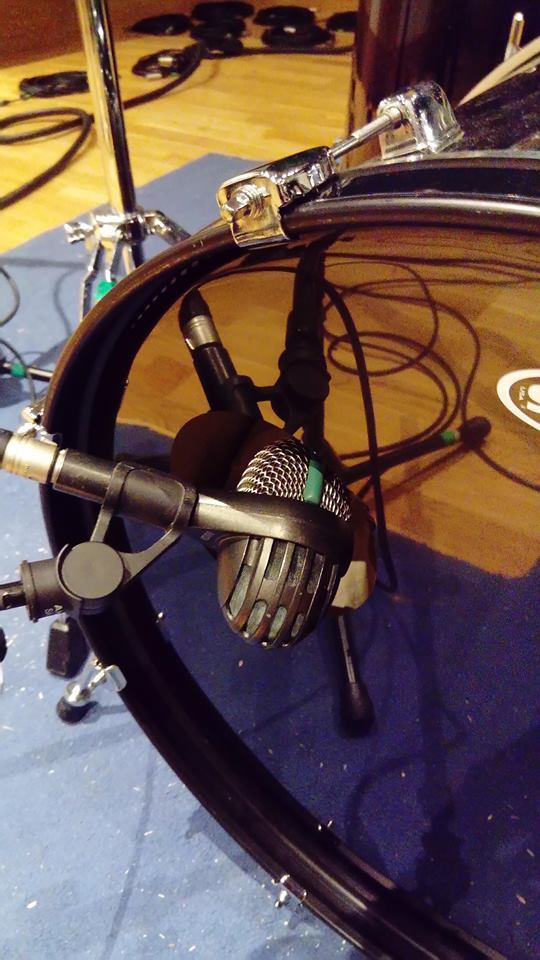

The Group has decided to book the studio for the 28th March 2018, which commences from 12:00, up until 16:00. The group decided that recording the drums first was the best option, so the guitar would be able to follow on the drums as a reference and manage to recreate the track.
The set-up for the drums was two overhead microphones (both Neumann KM 184’s), two microphones on the snare (both Shure SM57’s) and one microphone placed on the kick drum (AKG D112). The group decided to go with these microphones, as they were the best quality microphones available to use in that studio. Also, it was agreed on to go for this recording layout, because on the original track, the drum section has a defined snare and kick hit, throughout the whole song.
The drummer, managed to struggle recreating the drum part just using the click track, so a MIDI track was found. This helped the drummer, because it was easier to refer to the MIDI version of the drum track, only because it shows on how the song should be played.
The recording was done as a full take for a few times, but a member suggested recording sections was better and easier. By doing this and comparing the segmented and the full recording, there’s less error on the segmented parts, so the group decided to do this in the future too, because less time would be wasted on post-editing and re-recording.
Now it was the bassist’s turn to record the bass part. Finding a suitable bassist player was relatively easy to do, as one member of the group volunteered to play the bass guitar and it was a good choice, as the bassist seemed confident to recreate the track.
This time the set-up was easier, as it was only required to use less microphones that the drum kit, which it was only two microphones and a DI Box, to record the bassist. These microphones were used specifically to emulate the same sound on the original track, which it has a slight reverb implemented, so an ambience microphone was used (Shure SM57) and one microphone towards the amp (Sennheiser MD 421). The amp microphone was placed on-axis to minimize the amount of distortion made during recording and to also pick up all the sound emitted through the amp, as “Unidirectional microphones are most sensitive to sound coming from directly in from of them ie at an angle of 0o - we call this ‘on-axis sound’…” (Pawera, N).
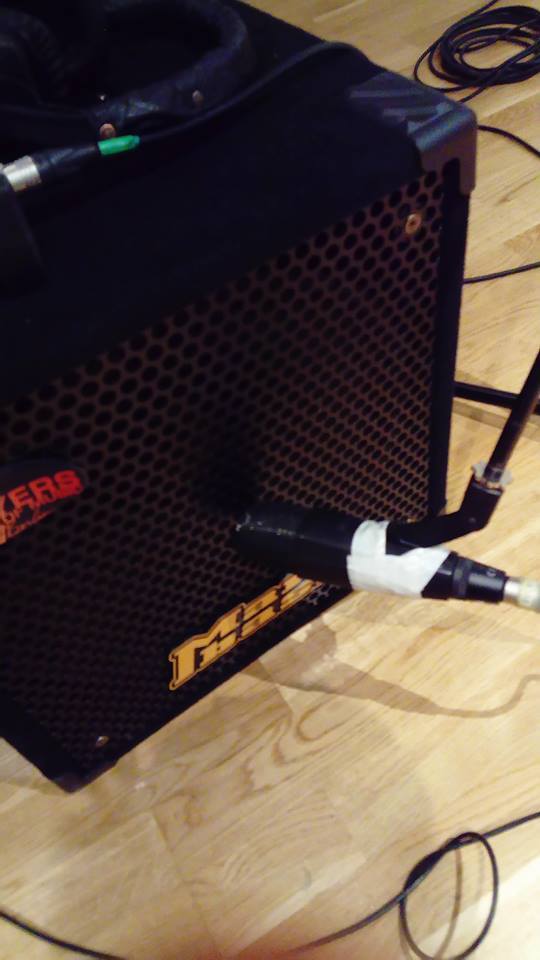
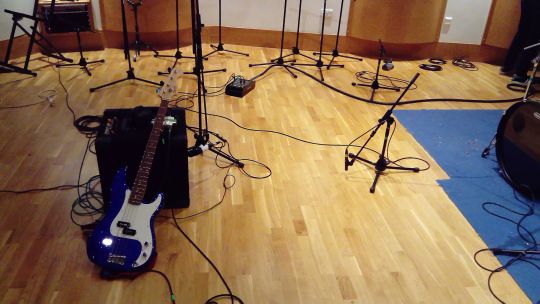
Then the group agreed upon to record the bassist only from the introduction to the first chorus only and allowed the bassist to use both the drum recording and the MIDI for referencing the song. Afterwards, the bass section was looped up until the last few bars, only because on the original, it has a note that will hang in the air for a few seconds, so that part was recreated by recording it separately.
References
· Pawera, N. (2010), Practical Recording 1: Microphones, SMT
0 notes
Text
Introduction of the project
This project will be about recreating a commercially successful song and it will be a group based work. The group will consist of three people which are Ali Mao Mahad, Filip Wasilewski and Natalia Witek, as it’s encouraged to work as a group for this project, since the assignment states that this is a group work.
For the song that the group will be trying to recreate, research was made to choose the most suitable producer for this project and it was Butch Vig who came at the top of the list over the other producers. Butch Vig managed to outshine the others because, firstly, the majority of the group likes the cultural impact on music production and the commercial success Butch Vig has made. The group also agreed upon choosing a hit song that Butch has created and that would be Nirvana’s ‘Come As You Are’.
This came in factor because, some group members have connections to musicians who could recreate this song. Another reason would be that, the song ‘Come As You Are’ came from one of Butch Vig’s most influential album called ‘Nevermind’.
The other producers that the group considered were Jack White who produced the White Stripes (while also performing for them), Steve Albini who produced the Pixies and took part on producing Nirvana’s second album titled ‘In Uterior’ and Mark Ronson, producer of Adele’s album named ‘19′. The reason that none of these producers were picked, was because of the lack musicians around who could’ve recreated one of the songs these producers made.
0 notes